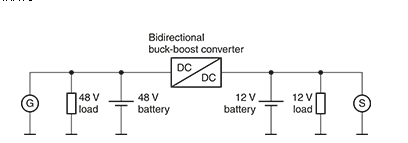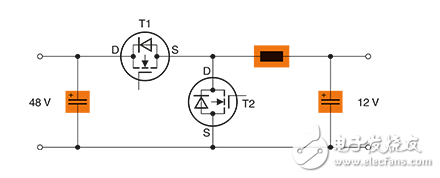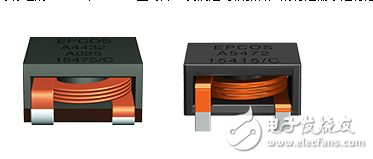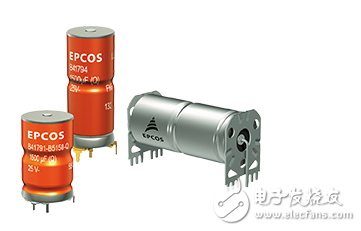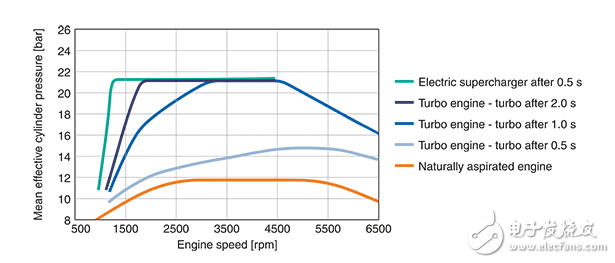The on-board 48V technology has some unique advantages: It helps reduce overall fuel consumption, reduces environmental hazards, and even improves engine performance. The core component of this technology is a powerful buck-boost converter, and the TDK Group provides the converter with key passive components: power inductors and aluminum electrolytic capacitors. With the development of complex power transmission management systems, auxiliary electronic heating and other comfortable systems, ABS (anti-lock braking system), ESP (electronic body stabilization system) and other security systems, and many other systems are increasing, the vehicle's electrical load is increasing. , It gradually became a large energy consumer. At the same time, it has steadily increased the power level of alternators. In the early 1880s, even the luxury vehicles whose alternators output only about 0.7 kW of power. However, the current power output required for the vehicle has reached 3.5 kW, which is almost 7 times the original. The problem that ensues is that if the 14V alternator outputs such a large amount of power, it means that the generator output current will be as high as 250A. At this voltage/current ratio, the efficiency of the generator is only 70%. This requires the engine's input power to the generator to reach 5 kW. Another disadvantage of the large current is that it requires that the cross-sectional area of ​​the conductor must be large, which leads to a significant increase in vehicle weight and overall cost. With the increasing demand for reducing fuel consumption and CO2 emissions, the market urgently needs to find targeted solutions. The 48V technology came into being and brought many advantages because it enabled many energy-saving measures that could not be solved only through the 12V system. Its features include: When the power is more than 5kW, the energy recovery efficiency is high Expanded start and stop features, such as slow start or smooth stop Electrification units such as turbochargers and electric power steering systems The 48V system does not completely replace the existing 12V architecture. On the contrary, this method can not help but allow us to expand the 12V system to handle higher power loads while also coupling the 48V system into these systems through a lift converter unit. Figure 1 explains the principle of this architecture. Conventional lead-acid or lead-acid colloidal batteries are used for 12V grades, while lithium-ion batteries are used for 48V grades. Double-layer capacitors can also be paralleled here to improve the storage of electrical energy during recovery. Figure 1: Architectural principle of the integrated 12/48V onboard power supply The main improvement is to set the generator level to 48V to achieve higher power output and energy efficiency ratings. Both voltage levels are connected via a two-way buck converter device. In the integrated 12/48V system, the most important component is a lift converter that allows energy to flow bidirectionally between two different voltage levels and can provide 2 to 5 kW of power output. Figure 2 shows the schematic of this converter. In normal mode, the converter acts as a buck converter and outputs the power generated by the 48V system into a 12V system. In this mode of operation, T2 is always in the blocking state, and T1 operates as a switch. If you need to output 48V voltage level, you must use boost mode. In this case, T1 is always on and T2 is operating in pulse mode. In order to minimize the ripple current and voltage, 6 or 8 modules need to be connected in parallel in practical applications. Figure 2: Buck converter circuit diagram In addition to switching transistors, EPCOS power inductors and energy storage capacitors are also the core components of lift converters. The TDK Group has developed two new EPCOS power inductor series as converter energy storage and smoothing chokes. For example, surface mount (SMD) type ERU 27 series inductors have high current capability and a compact package with an area of ​​only 30mm & TImes; 27.8mm (left side of Figure 3). Its insertion height is 15.5mm or 20.3mm, depending on the inductance. This compact design uses a flat winding with a high fill factor to achieve this. The inductors come in six different models. The inductor range covers the 3.5μH to 15μH range and the saturation current intervenes between 19A and 49A. In order to improve the mechanical stability of the component on the PCB, in addition to the two winding pads, the product also adds a third pad. In addition to this SMD product, the EPCOS ERU 33 series with PTH terminals (right side of Figure 3) is available for applications with a rated inductance of 3.2μH to 10μH, depending on the model. To ensure that the saturation current is 79A, the resistance of the inductor is only 0.85 mΩ. This series of power choke size 33mm & TImes; 33mm & TImes; 15mm, for the operating temperature range of -40 °C to +150 °C, and RoHS compliant, passed AEC-Q200 reliability test. In addition to the standard ERU 27 and ERU 33 models, we can also customize them to the specific needs of our customers. Fig. 3: The flow capacity of compact EPCOS power inductors is up to 75 A In addition to the inductor, the core components of the buck converter also include rugged aluminum electrolytic capacitors for energy storage and smoothing. EPCOS B41689 and B41789 series (figure 4) are designed to meet the stringent requirements of automotive electronics products, with super-strong vibration resistance up to 60 times the acceleration of gravity. In addition, star welding and capacitor models with cathode plate contacts on both ends can also optimize the capacitor installation, keeping the equivalent series inductance (ESL) of the capacitor at a low value. Figure 4: EPCOS aluminum electrolytic capacitors for automotive electronics have superior anti-vibration performance up to 60g and a maximum operating temperature of up to 150°C. Due to the built-in multiple contacts, the equivalent series resistance (ESR) of these capacitors is also quite low, resulting in higher ripple current capability and lower losses. When the ambient temperature is 125 °C, these capacitors have a continuous ripple current capability of 29.5 A, depending on the capacitor type. Among them, the automotive series is designed for applications with rated voltages of 25V, 40V (or 12V) and 63V (or 48V). At these voltage levels, they can operate in new vehicle-mounted power systems with two different voltage levels. The capacitance of this capacitor can be from 360μF to 4500μF. In addition to core components such as power inductors and aluminum electrolytic capacitors, buck converters also include a range of other TDK Group components such as multilayer ceramic capacitors (MLCCs), current transformers, and varistors. In addition to conventional electrification units such as pumps, the 48V technology also improves the efficiency of the engine through an electronic turbocharger. Conventional turbochargers are mainly driven by the consumption of gas, so their performance is closely related to the speed of the engine. In addition, they have a slight delay in operation, which we call "turbo lag." This disadvantage can be eliminated by electric chargers, especially when they require a fast response at lower engine speeds, such as in urban areas, thereby increasing the efficiency of the engine (as shown). In addition, it has the following advantages: The electronic turbocharger can be combined with a conventional turbocharger to further increase the charging voltage, or to turn off the electric charger when the engine speed reaches a high level. Oil-immersed Distribution Transformer, its HV level is 11kV, LV is 400V, its capacity is 2500kVA and below. Generally installed on the pole or in the distribution room, for lighting or power supply, three-phase power supply, fully sealed tank structure, to ensure the transformer safe and reliable operation. Three Phase Transformer,11Kv Distribution Transformer,High Quality 2500Kva Transformer,11Kv Oil Immersed Transformer Hangzhou Qiantang River Electric Group Co., Ltd.(QRE) , https://www.qretransformer.com